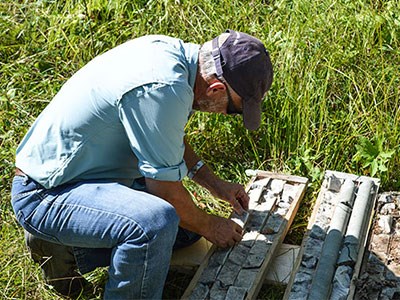Lithium is the new gold in the Kenora district.
With the price of the industrial metal going through the roof, the future demand for lithium has as much open-ended potential as Don Bubar’s Separation Rapids project, near Kenora.
Exploration companies are scrambling around the globe to lock up sources of supply, but the president-CEO of Avalon Advanced Materials and his crew only had to dust off some old studies from their mothballed deposit in northwestern Ontario.
Avalon expects to release a preliminary economic assessment in July or August, which will include the details and numbers of designing an extraction process to make lithium hydroxide to meet the anticipated demand for the auto sector.
“That’s obviously where the biggest growth is right now,” said Bubar, whose company picked up the high-purity lithium property, 70 kilometres north of Kenora, in late 1996.
Avalon drilled off a 10-million-tonne lithium resource in the late 1990s and completed a pre-feasibility study, but hadn’t done much since.
“We really hadn’t done a lot except try to monitor the lithium market, looking for an opportunity to advance it,” said Bubar.
Back then, the rechargeable battery market was in its infancy and didn’t represent much of an opportunity, since the market was served by other low-cost producers.
“Everything’s changed since then,” said Bubar.
For years, lithium-ion batteries have been used in all kinds of electronic gadgets, but the demand for this metal is expected to reach new heights as carmakers like Tesla look to mass produce electric vehicles.
It prompted the company to ice its Nechalacho rare earth metals project in the Northwest Territories earlier this year to focus on Separation Rapids, and rebrand from Avalon Rare Metals to its current name.
Unlike other commodities where you mine it and convert it into a concentrate for a ready market, lithium is a specially engineered chemical product that must meet certain customers’ specifications.
Bubar said determining that final product had been a moving target, as the technology in lithium-ion batteries is rapidly evolving.
“You could design a product based on today’s needs, get into production three years from now and everything’s changed again.”
From the auto sector, there’s a growing demand for lithium hydroxide, the ideal feed for the battery chemistries, said Bubar.
So the company’s been working on designing a process to make it.
“We pretty much have to build it into the overall business model because there’s no one to send it to in North America.”
If the economics look good, Bubar said there’s no reason the final processing can’t be done in northwestern Ontario. “We think so. The infrastructure is there.”
Bubar said they also haven’t ruled out also supplying the glass ceramics market at some point, which was their initial focus in the 1990s.
As the deposit remains open at depth and along strike, he expects to launch a new drill program later this year.
“It would be helpful to have a better understanding of the overall resource potential in order to scale the operation appropriately.”
The financing climate for lithium-based exploration and development is getting better all the time, said Bubar, as investor awareness grows.
But to bring the project to the development stage, he wants to land some strategic funding partners, in the form of customers, who’ll put some skin in the game.
The reviving of Avalon’s lithium program is good promotion for the area, said Kenora district geologist Craig Ravnaas of the Ontario Geological Survey.
“We’ve got some of the highest number of known lithium occurrences in Ontario,” he said, that might have good economic potential.
“They just require the exploration activity.”
New Gold’s Rainy River gold mine development near Fort Frances is stealing most of the headlines, but Ravnaas said the district is “good shape” as the three-fold increase in lithium prices since last fall has generated more interest.
“The Dryden area has a really good pegmatite field with lithium in it, and a couple companies are working there, plus there are lithium occurrences around Ignace.”
Pegmatite is a typical host rock for finding lithium.
Ravnaas finds exploration activity in the district is at the opposite ends of the spectrum with a plethora of very grassroots programs in gold, lithium, copper, nickel, even diamonds near Fort Frances, to companies like New Gold, Avalon and Treasury Metals reaching the very advanced stage or moving into development.
“Don Bubar is a prime example. They’ve done the bulk of their work drilling off the deposit in the past, and now they’re into the economic end of it. We’ve got programs right on that edge.”




